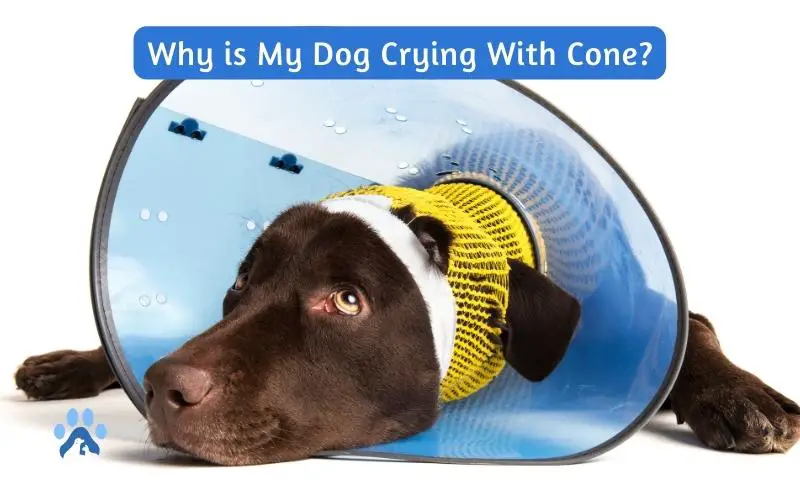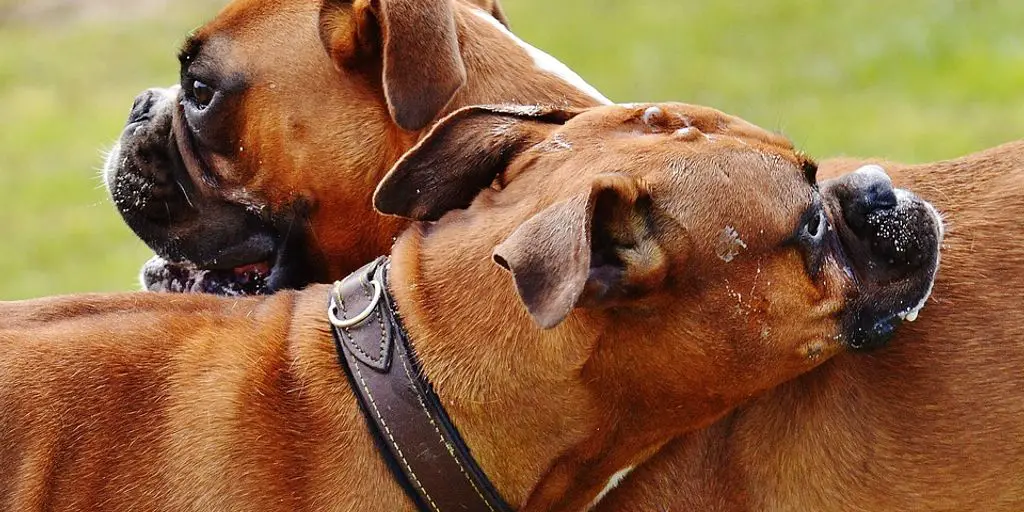When a beloved pet is diagnosed with an injury or illness, it can be difficult for both the pet and the pet parent.
The pet’s healing process can be filled with emotional ups and downs and often require using a medical device such as a cone.
The cone aims to prevent the pet from further injuring its healing wound or stitches.
In many cases, these devices can be complex for the pet to adjust, resulting in a dog crying with a cone. It usually happens because dogs feel uncomfortable wearing a new device around their neck that restricts their movements.
There are several possible reasons why a dog may be crying when wearing a cone. Some possible causes include:
- Discomfort: The cone may be causing discomfort for the dog, such as rubbing or pressing against the skin. This could cause pain or discomfort and lead to crying.
- Limited vision: The cone may be limiting the dog’s vision, making them anxious or scared.
- Restriction of movement: The cone may restrict the dog’s movement, preventing them from performing normal activities such as eating, drinking, or sleeping.
- Separation anxiety: The cone may remind the dog of a previous traumatic experience, such as a visit to the vet, causing them to feel anxious or stressed.
- Adjustment period: Some dogs may take time to adjust to wearing a cone, and may cry or whine during the adjustment period.
So, in this blog post, we will discuss the different ways a pet might respond to their cone, some other reasons why they may be reacting in a certain way, and how to help them feel more comfortable.
Let’s get started.
What are the Causes of a Dog Crying With a Cone?
There are numerous reasons why a dog wearing a cone can start crying. The most common is pain, but other reasons could be causing your dog to be in agony.
One of the most common reasons for a dog to be in pain while wearing a cone is because they have injured their teeth or jaws.
If your dog has been involved in an accident or bitten by another animal, it could end up with broken or damaged teeth. They may have severe discomfort as a result and find it difficult to consume food or drinks.
They also may suffer from an underlying medical problem. If your dog has an illness or injury, you are unaware of it. It could show signs of pain when wearing a cone. Taking your dog to the vet is crucial if you notice any changes in its behavior while wearing a cone.
There are also other reasons why your dog might be crying with a cone on that don’t relate to pain. Some dogs find it uncomfortable or restrictive to have something around their head and will try to get rid of it as soon as possible.
If your dog is one of them, you will often find them trying to remove their cone as soon as you turn your back.
It’s critical to take your dog to the vet for a checkup and diagnosis, regardless of why they are crying while wearing a cone. This will help you determine the best course for treating your dog’s condition and making them feel better as soon as possible.
What are the Causes of a Dog Wearing a Cone?
A dog wearing a cone is a common sight, usually due to a medical issue. The most common cause is to prevent the dog from licking or biting a wound or a surgical site. Dogs can irritate the wound by licking it or remove stitches or staples by biting.
In some cases, a cone may also be used to prevent a dog from scratching at a skin condition like flea allergies or hot spots. Other causes may include protecting the eyes from foreign objects or keeping the dog from licking off topical medications.
Dogs who require a cone shouldn’t be allowed to jump, run, or play too vigorously. Ensuring the cone is properly fitted and not too tight is also crucial. If the cone becomes loose or falls off, it must be put back on immediately.
How to Make a Dog Cone Comfortable?
If you’ve ever had to confine your dog to a cone, you know how unpleasant it can be. They can’t eat or drink normally, bump into things, and look pitiful. However, there are ways to make the situation tolerable for your dog.
Here are a few tips on how to make a dog cone comfortable,
Making adjustments to the cone can make it more comfortable for your pup. If the cone is too tight, you can add a soft cotton material to the plastic to create a cushioning effect. This will help reduce skin irritation from the edges of the cone rubbing against your dog’s neck.
Additionally, if you can access a sewing machine and some fabric, you can create a protective wrap that goes around the cone and adds extra padding.
You can also use foam pieces or an old t-shirt to provide additional cushioning around the edge of the cone. This will keep your pup’s neck safe and comfortable while they are wearing the cone.
Furthermore, if you want to reduce the visibility through the plastic, consider spray painting it with a light color that won’t irritate your pup’s eyes or skin.
Finally, give your dog plenty of breaks from the cone. Let them wear it for a few hours, then take it off to stretch their legs, move around freely, and quickly have their meals.
What are the Alternatives to the Plastic Dog Cone?
The plastic dog cone is the most common cone to prevent dogs from licking or scratching their wounds. However, a few alternatives to the plastic dog cone are,
Fabric cone
Fabric cones are made from a soft material, such as cotton, and usually have Velcro closure. These cones are less likely to rub against your dog’s skin and can be machine-washed if they get dirty.
Inflatable collar
Inflatable collars are made from a soft material, such as PVC, and they can be inflated to fit around your dog’s neck. These collars can be deflated when your dog is not wearing them.
E-collar
E-collars are also made from a soft material, such as PVC, but they have a built-in electric shock mechanism. These collars are designed to prevent dogs from licking or scratching their wounds, but they can also train dogs not to bark excessively or jump on people.
Conclusion
It’s important to remember that dogs may be distressed when wearing a protective cone. It is a good idea to keep a close eye on your pup and ensure they are not too uncomfortable in the cone.
If your dog crying with a cone or making noise, then it is best to consult with your vet to see if there is an alternative way to soothe them.
With the right approach, your pet will quickly forget that they are even wearing the cone and return to being their happy, playful selves.
Frequently Asked Questions
How do I get my dog to stop crying in the cone?
When a dog is wearing a cone, it can often be uncomfortable and cause distress. To help alleviate their unease, it’s essential to ensure the cone fits appropriately.
If the cone is too tight, it may be pressing too hard against their body or neck, causing discomfort.
Additionally, ensuring your dog is getting plenty of exercises and has access to its favorite toys or treats is essential.
If they seem particularly distressed, you can also try distracting them, such as a frozen Kong filled with treats.
How do you calm a dog with a cone?
When calming a dog with a cone, it’s essential to recognize the dog’s anxiety and fear of the situation.
Create a peaceful, safe setting with few interruptions. For example, a silent room.
Offer treats or toys to help keep the dog’s mind off the cone.
Speak in a calming tone to provide reassurance as you slowly and gently introduce the cone.
Allow the dog to take their time getting used to the device. It’s best to start with short periods with the cone, gradually increasing the time as the dog becomes comfortable.
Why is my dog so sad with a cone on?
A pet cone, or Elizabethan collar, is a large cone-shaped device worn around the neck to prevent pets from licking, scratching, or biting at a wound or medical area.
Understanding why the cone is necessary and providing extra love and comfort to help your pet adjust is essential.
It is usual for a pet to be disoriented or unhappy when wearing a cone, but with time, patience, and understanding, most pets will adjust and regain their normal behavior.
There are also alternative options to a cone, such as an inflatable collar or a t-shirt with the sleeves cut off to provide a less restrictive option.
How long does it take for a dog to adjust to a cone?
A dog normally needs a few days to get used to wearing a cone. Owners should be prepared to provide extra attention and patience during this time.
Dogs may experience distress and anxiety when first wearing a cone and may take longer to adjust if they have a history of separation anxiety or have a negative association with being handled.
Therefore, during the adjustment period, owners can help their pets become more comfortable with the cone by taking them on walks and playing with them while they wear it.
Should you give your dog a break from the cone?
Sometimes, giving a dog a break from a cone may be beneficial.
A cone can be uncomfortable and irritating for the animal and is usually only necessary after a medical procedure or to prevent them from causing further injury to themselves.
A brief break from the cone may be advised if the pet can be trusted not to lick or scratch at the area in question.



